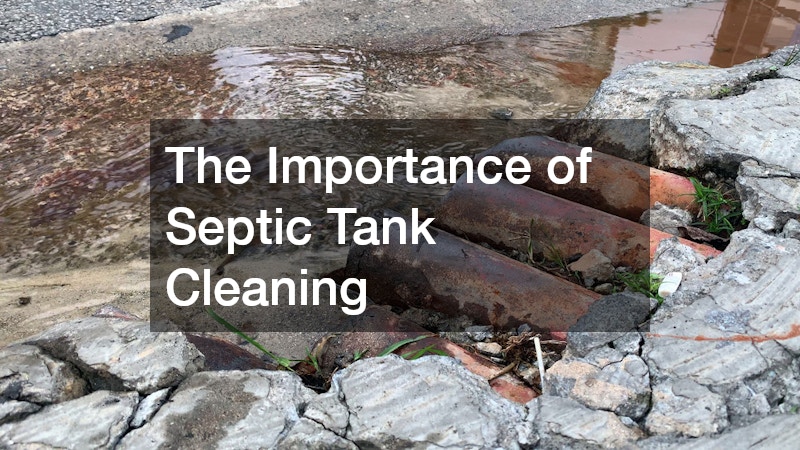Septic tanks play a critical role in managing wastewater for millions of homes and properties not connected to municipal sewer systems. Although often out of sight and out of mind, these underground systems are vital to public health, environmental protection, and property functionality. Understanding how septic tanks work, what affects their performance, and how to maintain them can help homeowners avoid messy and costly problems.
What Is a Septic Tank?
A septic tank is a watertight underground container typically made of concrete, fiberglass, or plastic. It is designed to hold and treat wastewater from household plumbing, including toilets, sinks, showers, and laundry systems.
Once wastewater enters the tank, it separates into three layers: solids (sludge) settle at the bottom, oils and grease (scum) float to the top, and liquid (effluent) stays in the middle.
The tank uses anaerobic bacteria to break down organic matter. While solids remain in the tank, the effluent flows out into a drainfield where further treatment occurs as it percolates through the soil. This process helps remove harmful bacteria, viruses, and nutrients before the water reaches groundwater supplies.
Components of a Septic System
A typical septic system includes several key components:
-
Inlet Pipe: Carries wastewater from the home into the septic tank.
-
Septic Tank: The primary treatment structure where solids settle and decomposition begins.
-
Baffles or Tees: Direct the flow of wastewater and help prevent scum and sludge from exiting the tank.
-
Outlet Pipe: Allows the treated effluent to flow into the drainfield.
-
Drainfield (or Leach Field): A network of perforated pipes buried in trenches filled with gravel or sand, which filters the effluent.
-
Soil: Acts as the final treatment and disposal component, removing pathogens and nutrients.
Understanding each component helps in recognizing the importance of proper care and routine inspections.
How Septic Tanks Treat Wastewater
Once inside the septic tank, waste undergoes a natural treatment process:
-
Separation: Heavier solids fall to the bottom, forming a sludge layer, while lighter oils and grease float to the top as scum.
-
Decomposition: Anaerobic bacteria digest some of the solids and reduce the volume of sludge.
-
Flow: The liquid effluent in the middle flows into the drainfield, where it undergoes additional filtration and microbial treatment in the soil.
This system works effectively when balanced, but improper use or neglect can lead to system failure.
Common Problems with Septic Systems
Several issues can arise when septic systems are not properly maintained:
-
Clogging: Excessive solids, grease, or non-biodegradable materials can clog pipes or the drainfield.
-
Overloading: High water usage can overwhelm the tank and drainfield, reducing treatment effectiveness.
-
Root Intrusion: Tree roots can infiltrate and damage tank walls or drainage pipes.
-
Backups and Overflows: These often occur when sludge builds up or the system becomes blocked.
Recognizing early warning signs—like slow drains, foul odors, or pooling water near the drainfield—can help prevent major failures.
The Importance of Septic Tank Cleaning
Routine septic tank cleaning is essential for maintaining system performance and preventing costly repairs. Over time, the sludge and scum layers build up and reduce the tank’s capacity, impairing the separation process and increasing the risk of solids flowing into the drainfield. If this happens, the drainfield can clog, leading to system failure and potentially contaminating groundwater.
Professional cleaning removes accumulated solids, restores tank function, and ensures the system operates efficiently. How often a tank needs cleaning depends on the tank size, household size, and water usage habits, but regular inspection is key to setting an appropriate schedule.
Tips for Septic System Maintenance
Maintaining a septic system doesn’t require complex tools or knowledge, but it does demand consistency and care. Here are a few tips:
-
Limit Water Usage: Use water-efficient appliances and fix leaks promptly to prevent system overload.
-
Be Mindful of What You Flush: Only flush human waste and toilet paper. Avoid disposing of wipes, diapers, grease, and chemicals down the drain.
-
Space Out Laundry Loads: Spread out water use to avoid flooding the system.
-
Use Septic-Safe Products: Choose cleaning products that are labeled safe for septic systems.
-
Avoid Parking or Building Over the Tank or Drainfield: This can compact the soil and damage system components.
When to Call a Professional
While some basic maintenance can be done by the homeowner, tasks like septic tank cleaning and thorough inspections should be handled by licensed professionals. They have the tools and experience to assess sludge levels, check for cracks or leaks, and ensure the drainfield is functioning properly.
You should schedule an inspection at least every three years and arrange cleaning as needed. Early intervention can extend the lifespan of the system and reduce health risks.
Understanding your septic tank system empowers you to take better care of it. With proper use and consistent maintenance—especially regular septic tank cleaning—you can ensure the system functions effectively for decades. A healthy septic system protects your home, your yard, and your community’s water supply. Treat it as the vital infrastructure it is, and it will serve you well for years to come.



